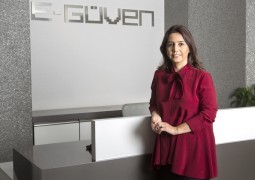New Era for CRM Systems – Jujhar Singh @Microsoft
by 0

“How do you combine and apply intelligence on top of System of Record to create experiences? That’s the key. All three elements shall be incorporated: System of Record, System of Engagement and System of Intelligence. Microsoft’s focus is customer engagement.”
At Microsoft Event we had a fruitful interview with Jujhar Singh, Microsoft Corporate Vice President of Dynamics CRM.

You talk about the systems that are united into one platform. Please tell us about the transformation of CRM systems.
If you a look at the prior CRM systems, they were Systems of Record. In a universe where the company controls all customers’ communication, the company puts everything that they do on the client side into a system of record, like incoming leads, opportunities, etc. That universe has completely changed. Now, it is an age of the empowered customers, who want information at their fingertips, not to be told how to go about with a company and self-sculpt their experiences. They want to pick up any channel any time with an extreme personalization and don’t trust the companies completely. They trust their peers. They go and ask on Facebook “hey, tell me what car I shall buy?” So, it’s the whole age of the empowered customer has resulted in building systems with a focus on engagement but not just being systems of record.
The social media is much more powerful.
Yes, what is happening in the social world? Providers try to figure out how to make sense out of it. They can engage with the customers in communities, on social channels and different places. They can make their company and product services available in a fashion that clients can consume them on their taste. That’s where the second transition Systems of Engagement comes in. The final one, where we believe that the real value will be brought by Systems of Intelligence. Now, companies have the Systems of Records sitting there which have kind of information what people are specifically asking the companies. They have the Systems of Engagement which sees what is happening on the web and the social media and try to make sense out of them. How do you combine and apply intelligence on top of them to create experiences? That’s the key. All three elements shall be incorporated: System of Record, System of Engagement and System of Intelligence. Microsoft’s focus is customer engagement.
How does Microsoft do it?
On the social side of the house, there are millions and millions of tweets that are coming out. For a company; it is critical to figure out which actions to take on. That is where we came in. Through Microsoft Social Engagement System, we can collect incoming tweets real-time, apply machine learning and figure out, “Is this a person asking for a particular product? Is it lead? Is it a complaint?” So, employees can start taking action accordingly.
What is the logic of machine learning?
Machine learning parse elements to figure out what they are. Sentiment Analysis is also used. For ex. I can send a tweet saying “this presentation was bad.” The sentiment of that tweet is negative. So, a system will mark the sentiment to be negative. It will mark things as a legal case or a complaint also, but it is possible to remark something, and the system can learn.
Is it available only in English?
It is available in 19 languages. Arabic, Japanese, and Chinese have been just added. Along with that, there are other 16 languages we support. We do native Sentiment Analysis, which means we do not convert it into English, we do it directly with native languages.
The way of doing business is also changing. The companies have to improve their processes also, right?
Correct, that is the key. That is where we need engaged and empowered employees. If your staff cannot respond to all these changes happening in real-time, there’s no way you can deliver qualified customary.
Exactly, today with your services it is possible for a sales person to have a Skype conversation with the lawyer while signing the contract. So, the problem can be solved just-in-time.
Yes, that is where the whole Office 365 productivity tools are directly embedded. In the sense of employer productivity, we focus on 4-5 key pillars to provide fastest business processes. Companies can define their processes on their own without a need to an IT person. A business person can go and set them. Those processes can be changed in real-time, too.
Today, if there is a need to change a business process in the company, it may become extremely hard. Companies have to build a model from day one to deploy everywhere, anytime. They make their business logic once; they can change it when needed in real-time. Then, we will deploy that to all mobile devices so that they use on all different channels.
How many percent of the companies are organized for such a dynamic process?
It’s difficult to say percentage wise at the macro level. The crucial thing is the Cloud and Systems of Intelligence revolution. The adoption varies across different companies and also industries. For example; high-tech companies are at the cutting edge of the Systems of Intelligence. They are much more open to adopting all of these new technologies like opportunity scoring and predictive forecasting. High-tech companies are very far ahead of that goal. Businesses in the public sector are usually at the low end of the curve. I can say most of the companies have Systems of Record, but Systems of Intelligence is at the start.
 Please tell us about Fantasy Sales.
Please tell us about Fantasy Sales.
We’ve acquired a company called “Fantasy Sales,” which is a gamification company. The focus is to keep the employees not empowered but engaged. If somebody is involved in doing certain things, it means he would put much more effort into that. In the USA, American football is famous. We tried to model the concept of that play as fantasy football. I can recruit my team out of the team players, every week they play, based on the games, they can see what the scores are. Same way with this particular case like fantasy football, you can within your organization, build, and recruit teams, set revenue and different targets. The beautiful part is everyone can participate. You can put any types of goals, which are integrated into the CRM Systems. In a call center scenario, you can say rules like “the specialist, who has achieved the closest X number of calls in less than one minute, gets 10 points.” You can see the results, show up at the board meeting and it becomes fascinating.
What is the ROI (return-on-investment) for your customers when they use Microsoft 360?
That depends on what kind of areas the client will use it. In case of sales; there are questions like “how quickly the deals are closed?”, “how productive the sales people are?” Sales people can concentrate on sales instead of spending a lot of time doing office work. We have high double digits of ROI in those particular areas. When you check the customer service; in that field the response time to the client is critical. For ex. SCI (Service Corporation International) used our products and their average orders size was increased by 113%, and the number of leads created grew by 88 %. So, it all depends on upon different scenarios, but companies see huge ROI. Addition to that with the way we organize things, they do not need to go for a big bang for everything. Businesses can pick up sales, service and marketing and do anyone of those in phases.
What’s your vision about the big data?
Big data in my mind is going to be truly transformational in the Customer Engagement. Earlier the issue was to bring massive sets of data and make them actionable in real-time. When you are interacting with your clients, if you can do, bring massive amounts of evidence, process them in real-time, do analysis on it and make it available to people who are responding to the customers’ needs, it changes the whole experience. If they can figure out that you went to their website, talked to them on the social channels, bought two products from them, engaged in the community and doing real-time interactions and if the agent is with you, you know that you are going to get a highly personalized experience. And you are going to be delighted by that. That’s the power of what the big data brings to the table.





